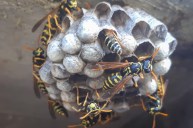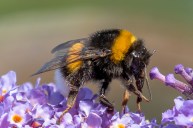When you think of bee deaths you probably envision a fly swatter. Either that or some sort of canned spray that shoots at least 40 feet so you don't get stung. However more bees dies from your driving than any of that. Ever wonder why your windshield is so dirty? It isn't just pollen. Millions of insects, including bees die each year due to collisions with cars. If you're wondering why you should care that cars contribute to bee deaths, just know that it is having a direct impact on the economy and the environment.
How Cars Contribute To Bee Deaths And Why You Should Care

Shutterstock Photo (search bee sting).
The NY Post shared that new research finds "millions upon millions of bees are killed in collisions with cars in the United States annually." The study was conducted in Utah, where sticky traps were "fixed to the bumpers of mid-size cars." After the research was collected it researchers estimated that hundreds of millions of bees would be killed every summer.
Why should you care that millions of bees are be killed by car collisions? Bees have a direct impact on our environment. While we may not like the way they sting, they are one of the most important pollinators. With their already dwindling populations, learning how cars contribute to bee deaths is an important factor in protecting bee populations.
Just to show you how important bees are, the NY Post shares that "bees pollinate about a third of the world's food supply and their natural service are valued at nearly $20 billion annually." In an order to attempt to save the bees researchers have started to notice patterns.
Bees tend to avoid "crossing roads if no vegetation grows from its median." So, a quick solution is to only have vegetation on the sides of the road rather than in the middle. This simple solution could be the first giant step in the right direction in helping the dwindling bee population.




